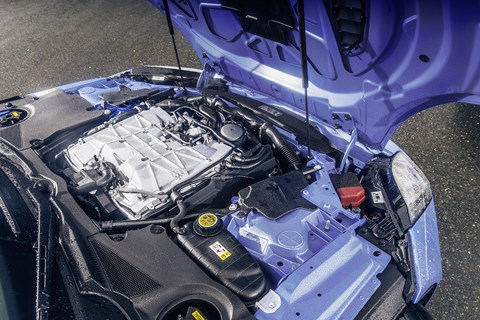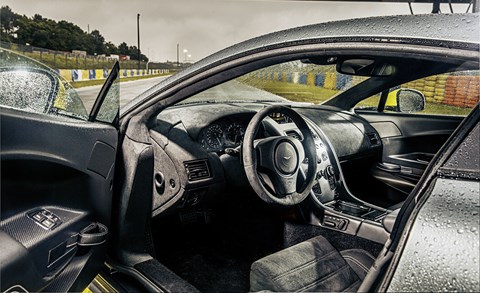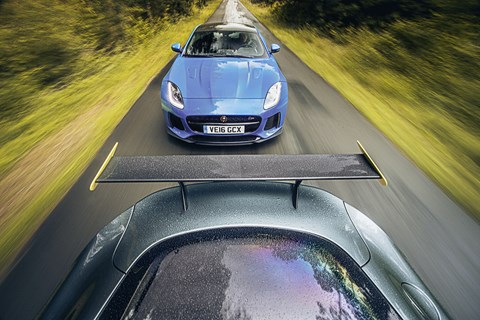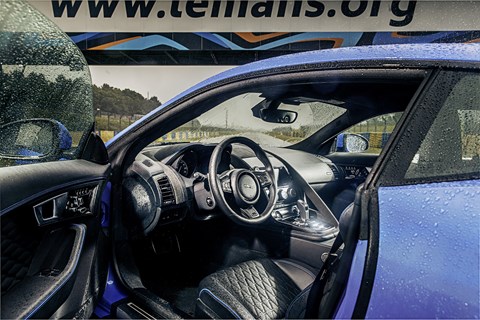► Aston Martin GT8 vs Jag F-type SVR
► Battle of the British V8 super-coupes
► Full twin test review by CAR magazine
Following Britain’s decision to disentangle itself from Europe, Europe wants us out as fast as possible. And this pair is about the fastest home-grown conveyances we could find in order to make that happen: the Jaguar F-type SVR and Aston Martin Vantage GT8.
Did someone spill millions of gallons of Red Bull into the Midlands’ water supply? Because before we even consider this pairing, it’s worth remembering what else is going on with these storied marques. On the one hand Jaguar is finally about to make it big with the F-Pace SUV while next-door, at Gaydon, Aston Martin is off the ropes and fighting back. After years of merely getting by it’s been invigorated by new funding and a components tie-up with Daimler, and is ready to unleash a slew of hot new product including the DB11, a hybrid crossover and, with a little help from Adrian Newey, a supercar.
Not that either marque has forgotten about its core content. Front-engined sports cars are central to both makers’ lineups; have been since before even the glory days of the 1950s, when the two firms duked it out in the World Sports Car Championship with their D-type and DBR racecars. Now, for 2016, both Aston’s V8 Vantage and Jaguar’s F-type have been reworked into new flagships that take both cars to new levels of performance – and price.

While the Aston takes its inspiration from a full-blown racer – Aston Martin Racing’s V8 Vantage GTEs finished fifth and sixth in class at Le Mans this year – the Jag attempts to crank up the existing F-type R’s extrovert blend of performance and usability to 11. Two years ago we pitted the then new F-type R against Aston’s V12 Vantage and found narrowly in favour of the less involving but more polished Jag. Given the difference in ethos between the two, not to mention the £50k gulf in price, a direct comparison would be more than a little unfair this time around. But just how different are they, and whose take on the British sports car template is the most compelling? We’re curious to find out. With the keys to 1008bhp, you would be too.
Aston Martin Vantage GT8 and Jaguar F-type SVR: to Le Mans!
To find out more about our pair we’ve come to Le Mans just as the crowds are dispersing in the wake of the 2016 24 Hour. ‘Racing is life,’ Steve McQueen said famously – ‘Everything that happens before or after is just waiting.’ He might have been thinking about Le Mans the race, but he could have been talking about Le Mans the place. Sorry to spoil the romance but as far as we can tell it’s an absolute dump, with no redeeming features beyond a cathedral and a weekend on which some cars drive around in circles noisily for a long time (two weekends if you included the Le Mans Classic). CAR’s James Taylor sums it up succinctly: ‘If Peterborough had a 24-hour race.…’
The race crowds might have disappeared following Porsche’s hollow victory in the wake of Toyota’s last lap breakdown, but the place is a hive of activity. All around the circuit, racing cars are being loaded onto trailers, cranes are dismantling marquees and motorhomes chug from gates. When you turn up for race weekend as a punter you likely never spare a thought for the monumental effort that goes into building and then breaking down the infrastructure that makes the event possible. A glimpse behind the curtain is a humbling experience.
There’s so much going on, in fact, that we manage to bluster our way through security and right onto the shorter Bugatti circuit MotoGP uses based purely on looking the part. Oh yes, do we look the part. The Aston looks instantly at home, largely because it looks almost exactly the same as Aston’s endurance racer. Inspired by the Vantage GTE competition car, the GT8 is the most powerful V8 Vantage ever. In essence, it closely follows the lead set by 2015’s GT12. If you remember, that car was a £250k 100-off monster based on the V12 Vantage S. The GT8 follows in its shadow, but swapping the V12 for a V8 means it’s the lightest road-going Vantage we’ve seen yet.

And though it’s down four cylinders and 1.3 litres, it’s every bit as focused as its GT12 brother. To achieve its 1510kg kerbweight – a full 100kg less than a V8 Vantage S and 55kg below the GT12 – Aston’s engineering team lavished the GT8 with carbonfibre, fashioning the front splitter, front and rear bumpers, wings, side sills and rear diffuser from the stuff. There’s a lithium-ion battery and carbon sports seats as standard, while a host of other stuff that ought to be standard like a carbon roof, polycarbonate rear screen and rear side windows, a titanium centre-mounted exhaust, centre-lock wheels and an Aero pack including the high-rise wing, must be added optionally.
Prices, specs
The price of all this is steeper than Aston’s uphill struggle to overthrow its forced-induction rivals on-track. Base price is £165,000, twice the price of a regular V8 Vantage, and that’s before you’ve factored in the attention-gaining and weight-shredding options mentioned above, and unique colour schemes like this car’s Stirling Green and Lime ‘Halo’ combo. Call it £200k. Call it madness when a 911 GT3 RS is £131,296.
And call the Jag a bargain in comparison. But only in comparison. At £110,000 for the coupe (£115,485 for the roadster) the F-type SVR is hugely cheaper than the Aston GT8, but hugely more expensive than even an F-type R, let alone a £52,000 V6 that it looks almost indistinguishable from it to the lay person. And it’s simply not as special in makeup as its Midlands rival.
Unlike the Aston, the Jag features no carbonfibre panels and claims no link to an endurance racing derivative. Neither is it particularly lighter than the already rapid F-type R, weighing just 25kg less in standard spec, or 50kg if you go for the carbon roof and ceramic brakes, and you can already get those stoppers on the R anyway.

But it does have one special number in its favour: 200. The F-type SVR is a genuine 200mph machine, making it the first Jaguar since the XJ220 of the early 1990s capable of cracking the double-century, and 10mph faster than the GT8 on a hypothetical blast down a traffic- and chicane-free Mulsanne.
The SVR’s active rear spoiler is designed to keep progress tidy and the handsome quilted leather seats dry at those speeds, but there’s little else to identify it from any other F-type, and there’s no denying the Aston looks faster. The Aston’s splitter and side skirts almost give the whole car the look of being splayed across the tarmac under the sheer weight of downforce, and the way the front wing is cut back after the wheel opening, just like the racer’s is a neat touch.
Inside the Aston GT8
Open the Aston’s door though, noticing the massively improved centre console lifted from the Vanquish, and the game is up. It might look a racing car but, while the bucket seats look suitably GT3-esque, and their carbon-backs and the carbon of the door panels show clear evidence of attention to weight saving, it’s as beautifully trimmed as any other Aston road car in here, and the sensible presence of both air conditioning and sounds suggests Aston still can’t quite bring itself to shrug off its luxury heritage, even on its most focused cars.
Those seats are surprisingly easy to get into, perhaps because they’re less supportive than they look, but curiously they’re still electronically controlled. They’re moulded in one piece so tilting the backrest back tilts the whole seat as if you’re about to be launched into outer space when you stomp on the go pedal.

You’re not. Top speed talk is nonsensical, but the Jag’s performance advantage is real at all speeds. What the bystanders can’t possibly imagine as they stare at the Aston’s huge aero appendages and frankly hideous dayglo detailing, and hear the bark from its huge exhaust pipes, is that it gets its winged ass handed to it every time we simultaneously open both cars up on every straight that comes along.
You don’t need to be a Le Mans winning engineer to see why, even with 195kg of ballast along for the ride, the Jag romps off into the distance. The Aston’s venerable V8, a very distant relative of the Jag’s own AJP-V8 thanks to both companies once being owned by Ford, started off at 4.3 litres and 380bhp in 2005, grew to 4.7 litres and 420bhp in 2008, and now, with the addition of a freer-breathing exhaust system, churns out 440bhp and 361lb ft. It feels leaden at low revs, a blip of the throttle from idle barely resulting in more than a solitary eyebrow raise from the rev counter, and when the needle does climb its way around the dial, the revs take an age to fall away again.
‘The GT8 sounds orgasmically good’
But get it into the midrange and beyond and it sparkles, piling on the revs and the excitement, pulling hard to 7500rpm on the unhelpfully red-line-free rev counter. It sounds orgasmically good, the rich multi-textured barrage of induction and exhaust noise dominating everything about this car in every instance, goading you into wasting not a single rev, and persuading you that the GT8 is far faster than it really is. Driven in isolation, ears ringing to that sound, the Aston feels properly rapid, so it’s disappointing to discover that it only clocks 4.4sec to 60mph (not even 62mph, note). And more disappointing still to watch the SVR waft by without breaking sweat.

That’s what 568bhp will do for you. More accurately, that’s what 516lb ft of torque will do for you when your rival is slumming it with 361. The SVR package doesn’t transform the F-type’s supercharged V8, but it was already pretty stout in R form. Here it makes an additional 25bhp – and mincemeat of the Aston, delivering the feeling of a car without inertia when you jump on the accelerator, hurling you onwards, and still hurling long after your brain tells you the thrust should be starting to fade. Helped by all-wheel-drive traction that’s optional on the R model a rung further down the ladder but mandatory on the SVR, the ultimate F-type is so outrageously sticky you can launch the car on a sopping wet road without a hint of slip.
The Jag scores 3.7sec to 62mph, making it almost a second quicker than the Aston in the dry and almost certainly far more today, in the pouring rain. The GT8 might be no torque monster but still, it’s grunty enough to be giving the rain-hating track-ready Michelin Pilot Cup 2 tyres some serious problems in these conditions, spinning the rear wheels in second and third gears with the traction control switched out and your right foot set to clumsy.
There are a couple of caveats though. First the Jag doesn’t wind as high, throwing in the towel at 6500rpm. And second, it sounds pretty fruity on full reheat, but even then it’s like listening to the GT8 from three rooms away. Much like the Aston’s kick in the back feels good until you’ve felt the Jag’s, so the F-type’s V8 sounds glorious until you’ve heard its opposite number at full chat.

From here though the pair parry like a couple of Wimbledon pros. The Aston’s pathetically languid Sportshift II single-clutch robotised manual ’box feels utterly objectionable in the wake of the Jag’s slick, and reasonably swift-shifting ZF auto. But then Aston Martin at least offers a proper manual transmission alternative for this car, something we’d insist you pick. With the Jag it’s two pedals or nothing, but at least the F-type’s shift paddles are easily reached, being fixed to the back of the steering wheel. The Aston’s are fixed to the column so you always know where they are. Which is invariably too far away if you’ve got any kind of lock wound on because the paddles themselves are too short.
Away from the Le Mans circuit, the Aston feels uneasily stiff-legged at low to medium speeds. Compared with the regular V8 Vantage the track is wider, the springs rates are up 25% at the front and 10% at the back, the ride height is lower, there’s more negative camber and race-grade suspension bushes. Porsche’s switch to adaptive dampers transformed its 911 GT3 when the 997 model was launched, showing just how usable a proper track-focused car could be, but Aston has instead gone for a set of high quality passive dampers and the urban manners of a Russian football fan. The big surprise is that the Jag doesn’t always settle that easily either, and it does have adaptive dampers.
On the open road: the natural habitat of the lesser-spotted GT
It feels more claustrophobic in the SVR, maybe due to thicker A-pillars and a higher scuttle. And the handling belies its extra heft. There’s real sensitivity to the Jag’s steering, which feels better than any F-type’s yet, even if it can’t match the delicious tactility of the GT8’s. It feels like its carrying a quicker ratio than the GT8 too, magnifying the urgency on turn-in, which is helped on the SVR by a softer front anti-roll bar and a stiffer one at the rear. But there’s always still that nagging sensation that the SVR feels like a big car, that it’s carrying those extra 195kg – two passengers – over the Aston.

Winding some speed into both these cars is like pouring them a stiff drink. Instantly they loosen up, and it’s the Aston that undergoes the biggest transformation, feeling far friendlier than on initial acquaintance, becoming more composed, but never losing that on-its-toes alertness that begs you to drive it harder. There’s no ambiguity in its responses to steering and throttle inputs – every movement feels deliciously pure and analogue, just like you’d want from a car escaped from the track and tempered just enough for road use.
The SVR isn’t so pure, or so rewarding. But it’s proving worth its considerable weight in gold in today’s weather. I love a bit of oversteer, but it’s hard to believe how much more controlled the F-type is and how many liberties you can take with the addition of this rear-biased four-wheel-drive system. In the dry it might be a different story, but on these roads the Aston’s Cup tyres, totally unsuited to the conditions, are frequently overwhelmed, letting go at the front, and then the back. You can feel the inherent balance in the chassis, but simply can’t exploit it, not today. On its more broadly capable Pirelli P Zeros the Jag treats the same surfaces as if they’d never seen a drop of rain in their lives, delivering every lb ft of twist when you call it up and summoning every last fraction of g-force from the brilliant optional carbon-ceramic brakes.
Verdict
James Taylor must drive the F-type back to the UK, leaving the Aston in France – how many miles will pass before he stops wishing he was in the racier car? Not many I’d wager. The Jag was made for days like this, for bouncing around backroads one minute then knuckling down to some serious motorway work the next.

That’s not what the Aston is about. It’s a purely hedonistic celebration of the unbridled pleasure of driving a properly focused car, of the rightness of the basic Vantage design and of Aston Martin’s love of racing. It’s also in no way worth the circa-£200,000-with-options each of the 150 deluded people who’ve snapped up each one have been fleeced for, though doubtless they’d think differently. Neither, we’d argue is the F-type SVR worth an extra £20k over an all-wheel-drive F-type R. Clearly Jaguar feels that this is where the money and the market is, and the SVR would make an excellent daily driver sports car. But wouldn’t it be great to see Jag’s SVO department really go to town on the F-type? Not with more of the same or another daft and rather cheesy Project 7, but with a proper driver’s F-type, something closer in concept to the GT8? Then maybe even reigniting that decades-old rivalry on track. Shall we say Le Mans 2018? Over to you, Jaguar.
Click here for more comparison test reviews by CAR magazine